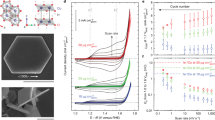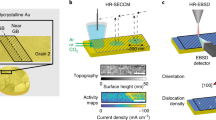Abstract
The topmost atomic layers of electrocatalysts determine the mechanism and kinetics of reactions in many important industrial processes, such as water splitting, chlor-electrolysis or fuel cells. Optimizing the performance of electrocatalysts requires a detailed understanding of surface-state changes during the catalytic process, ideally at the atomic scale. Here, we use atom probe tomography to reveal the three-dimensional structure of the first few atomic layers of electrochemically grown iridium oxide, an efficient electrocatalyst for the oxygen evolution reaction. We unveil the formation of confined, non-stoichiometric Ir–O species during oxygen evolution. These species gradually transform to IrO2, providing improved stability but also a decrease in activity. Additionally, electrochemical growth of oxide in deuterated solutions allowed us to trace hydroxy-groups and water molecules present in the regions of the oxide layer that are favourable for the oxygen evolution and iridium dissolution reactions. Overall, we demonstrate how tomography with near-atomic resolution advances the understanding of complex relationships between surface structure, surface state and function in electrocatalysis.
This is a preview of subscription content, access via your institution
Access options
Access Nature and 54 other Nature Portfolio journals
Get Nature+, our best-value online-access subscription
$29.99 / 30 days
cancel any time
Subscribe to this journal
Receive 12 digital issues and online access to articles
$119.00 per year
only $9.92 per issue
Buy this article
- Purchase on Springer Link
- Instant access to full article PDF
Prices may be subject to local taxes which are calculated during checkout




Similar content being viewed by others
References
Stamenkovic, V. R., Strmcnik, D., Lopes, P. P. & Markovic, N. M. Energy and fuels from electrochemical interfaces. Nat. Mater. 16, 57–69 (2017).
Seh, Z. W. et al. Combining theory and experiment in electrocatalysis: insights into materials design. Science 355, eaad4998 (2017).
Grimaud, A. et al. Activation of surface oxygen sites on an iridium-based model catalyst for the oxygen evolution reaction. Nat. Energy 2, 16189 (2016).
Grimaud, A. et al. Activating lattice oxygen redox reactions in metal oxides to catalyse oxygen evolution. Nat. Chem. 9, 457–465 (2017).
McCrory, C. C. et al. Benchmarking hydrogen evolving reaction and oxygen evolving reaction electrocatalysts for solar water splitting devices. J. Am. Chem. Soc. 137, 4347–4357 (2015).
McCrory, C. C., Jung, S., Peters, J. C. & Jaramillo, T. F. Benchmarking heterogeneous electrocatalysts for the oxygen evolution reaction. J. Am. Chem. Soc. 135, 16977–16987 (2013).
Reier, T., Oezaslan, M. & Strasser, P. Electrocatalytic oxygen evolution reaction (OER) on Ru, Ir, and Pt catalysts: a comparative study of nanoparticles and bulk materials. ACS Catal. 2, 1765–1772 (2012).
Beni, G., Schiavone, L. M., Shay, J.L., Dautremont-Smith, W. C. & Schneider, B. S. Electrocatalytic oxygen evolution on reactively sputtered electrochromic iridium oxide films. Nature 282, 281–283 (1979).
Cherevko, S. et al. Oxygen and hydrogen evolution reactions on Ru, RuO2, Ir, and IrO2 thin film electrodes in acidic and alkaline electrolytes: a comparative study on activity and stability. Catal. Today 262, 170–180 (2016).
Seitz, L. C. et al. A highly active and stable IrO x /SrIrO3 catalyst for the oxygen evolution reaction. Science 353, 1011–1014 (2016).
Willinger, E., Massué, C., Schlögl, R. & Willinger, M. -G. Identifying key structural features of IrO x water splitting catalysts.J. Am. Chem. Soc. 139, 12093–12101 (2017).
Spöri, C., Kwan, J. T. H., Bonakdarpour, A., Wilkinson, D. P. & Strasser, P. Stabilitätsanforderungen von Elektrokatalysatoren für die Sauerstoffentwicklung: der Weg zu einem grundlegenden Verständnis und zur Minimierung der Katalysatordegradation. Angew. Chem. Int. Ed. 129, 6088–6117 (2017).
Danilovic, N. et al. Activity–stability trends for the oxygen evolution reaction on monometallic oxides in acidic environments. J. Phys. Chem. Lett. 5, 2474–2478 (2014).
Minguzzi, A. et al. Easy accommodation of different oxidation states in iridium oxide nanoparticles with different hydration degree as water oxidation electrocatalysts. ACS Catal. 5, 5104–5115 (2015).
Reier, T. et al. Molecular insight in structure and activity of highly efficient, low-Ir Ir–Ni oxide catalysts for electrochemical water splitting (OER). J. Am. Chem. Soc. 137, 13031–13040 (2015).
Kötz, R., Neff, H. & Stucki, S. Anodic iridium oxide films: XPS‐studies of oxidation state changes and O2 evolution. J. Electrochem. Soc. 131, 72–77 (1984).
Pfeifer, V. et al. The electronic structure of iridium oxide electrodes active in water splitting. Phys. Chem. Chem. Phys. 18, 2292–2296 (2016).
Sanchez Casalongue, H. G. et al. In situ observation of surface species on iridium oxide nanoparticles during the oxygen evolution reaction. Angew. Chem. Int. Ed. 53, 7169–7172 (2014).
Reier, T., Nong, H. N., Teschner, D., Schlögl, R. & Strasser, P. Electrocatalytic oxygen evolution reaction in acidic environments—reaction mechanisms and catalysts. Adv. Energy Mater. 7, 1601275 (2017).
Wertheim, G. K. & Guggenheim, H. J. Conduction-electron screening in metallic oxides: IrO2. Phys. Rev. B 22, 4680–4683 (1980).
Chen, Y.-S. et al. Direct observation of individual hydrogen atoms at trapping sites in a ferritic steel. Science 355, 1196–1199 (2017).
Alia, S. M. et al. Activity and durability of iridium nanoparticles in the oxygen evolution reaction. J. Electrochem. Soc. 163, F3105–F3112 (2016).
Massue, C. et al. High-performance supported Ir-oxohydroxide water oxidation electrocatalysts. ChemSusChem 10, 1943–1957 (2017).
Gault, B. & Moody, M. P. & Cairney, J. M. & Ringer, S. P. Atom Probe Microscopy Vol. 160 (Springer Science & Business Media, New York, 2012).
Moody, M. P., Tang, F., Gault, B., Ringer, S. P. & Cairney, J. M. Atom probe crystallography: characterization of grain boundary orientation relationships in nanocrystalline aluminium. Ultramicroscopy 111, 493–499 (2011).
Fortes, M. A. & Ralph, B. The growth of oxide on field-Ion specimens of iridium. Proc. R. Soc. Lond. A 307, 431–448 (1968).
Li, T., Bagot, P. A. J., Marquis, E. A., Tsang, S. C. E. & Smith, G. D. W. Characterization of oxidation and reduction of Pt–Ru and Pt–Rh–Ru alloys by atom probe tomography and comparison with Pt–Rh. J. Phys. Chem. C. 116, 17633–17640 (2012).
Binninger, T. et al. Thermodynamic explanation of the universal correlation between oxygen evolution activity and corrosion of oxide catalysts. Sci. Rep. 5, 12167 (2015).
Geiger, S. et al. Activity and stability of electrochemically and thermally treated iridium for the oxygen evolution reaction. J. Electrochem. Soc. 163, F3132–F3138 (2016).
Özer, E., Spöri, C., Reier, T. & Strasser, P. Iridium(111), iridium(110), and ruthenium(0001) single crystals as model catalysts for the oxygen evolution reaction: insights into the electrochemical oxide formation and electrocatalytic activity. ChemCatChem 9, 597–603 (2016).
Chen, D., Chen, C., Baiyee, Z. M., Shao, Z. & Ciucci, F. Nonstoichiometric oxides as low-cost and highly-efficient oxygen reduction/evolution catalysts for low-temperature electrochemical devices. Chem. Rev. 115, 9869–9921 (2015).
Kasian, O., Grote, J.-P., Geiger, S., Cherevko, S. & Mayrhofer, K. J. J. The common intermediates of oxygen evolution and dissolution reactions during water electrolysis on iridium. Angew. Chem. Int. Ed. 57, 2488–2491 (2018).
Klemm, S. O. et al. Time and potential resolved dissolution analysis of rhodium using a microelectrochemical flow cell coupled to an ICP-MS. J. Elecroanal. Chem. 677–680, 50–55 (2012).
Acknowledgements
T.L. and O.K. acknowledge the Alexander von Humboldt Foundation. S.Z. and C.S thank the German Science Foundation within the Priority Programme SPP 1613 (DFG SCHE 634/12-2).
Author information
Authors and Affiliations
Contributions
K.J.J.M. and B.G. initiated the project. O.K. prepared Ir oxide films, performed the electrochemical and XPS measurements and carried out data analysis. T.L. prepared the APT and TEM samples, conducted the APT experiment and analysed the APT data. S.Z. carried out the TEM experiment. T.L, O.K., B.G., S.C., D.R. and K.J.J.M. wrote the paper. All authors discussed the results and their interpretation.
Corresponding authors
Ethics declarations
Competing interests
The authors declare no competing interests.
Additional information
Publisher’s note: Springer Nature remains neutral with regard to jurisdictional claims in published maps and institutional affiliations.
Supplementary information
Supplementary Information
Supplementary Notes 1–6, Supplementary Figures 1–8, Supplementary Table 1, Supplementary References
Rights and permissions
About this article
Cite this article
Li, T., Kasian, O., Cherevko, S. et al. Atomic-scale insights into surface species of electrocatalysts in three dimensions. Nat Catal 1, 300–305 (2018). https://doi.org/10.1038/s41929-018-0043-3
Received:
Accepted:
Published:
Issue Date:
DOI: https://doi.org/10.1038/s41929-018-0043-3
This article is cited by
-
Ligand effect on switching the rate-determining step of water oxidation in atomically precise metal nanoclusters
Nature Communications (2023)
-
3D atomic-scale imaging of mixed Co-Fe spinel oxide nanoparticles during oxygen evolution reaction
Nature Communications (2022)
-
Activating copper oxide for stable electrocatalytic ammonia oxidation reaction via in-situ introducing oxygen vacancies
Nano Research (2022)
-
Elucidating intrinsic contribution of d-orbital states to oxygen evolution electrocatalysis in oxides
Nature Communications (2021)
-
Efficient overall water splitting in acid with anisotropic metal nanosheets
Nature Communications (2021)



